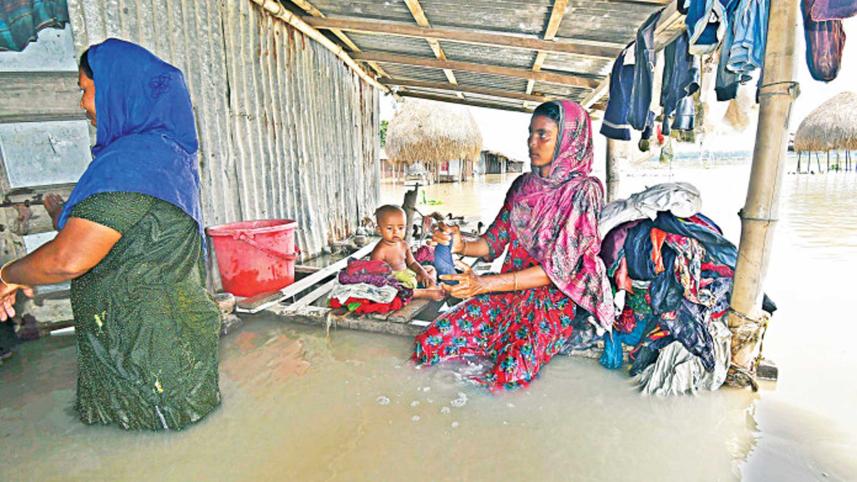Protect and rehabilitate victims of floods and river erosion

Last month, the UN's Intergovernmental Panel on Climate Change (IPCC) released their landmark report on climate change that was termed a "code red for humanity" by the UN chief. The section of the report that focused on South Asia warned of increased risks of death, injury, ill health or disrupted livelihoods due to storm surges, coastal flooding, sea-level rise and inland flooding. "The risk of floods, and loss of life and property associated with floods, is highest in India and Bangladesh," it stated.
In less than a month since the report came out, we are seeing the real-time impacts of climate change as predicted. According to a report in The Daily Star on Thursday, around 30 percent of Bangladesh's land area is set to be inundated as the water levels of the Jamuna and Padma rivers are forecast to continue rising over the next three days. People from flood-affected districts have already been forced to leave their homes—many of them taking shelter, along with their furniture and livestock, on government roads and Water Development Board dykes—and there is an emerging crisis of food and drinking water. Reports from different districts paint a bleak picture of government assistance with delays in providing relief, inadequate relief or no relief at all.
According to a bulletin from the Flood Forecasting and Warning Centre, of the 109 water measuring points in different rivers, water is flowing above the danger level at 16 points, while water levels at another 50 points are increasing. Given that these changes in water level are being monitored and updated, there really are no excuses for the authorities for not having relief mobilisation and distribution measures in place. The provision of shelter, even for the short term, could also have been done, in the same way such efforts are organised during cyclone warnings.
However, there is a deeper issue that must be highlighted here. Despite the fact that global climate change is having serious negative impacts on Bangladesh, we cannot shy away from our own responsibilities in causing environmental destruction and failing to stop river erosion—both of which have contributed to the current state of affairs. On Thursday, this daily told the story of Jalalpur village in Sirajganj's Shahjadpur upazila, where 500 homesteads, a school and three mosques were lost to the Jamuna River in monsoon, and the remaining 100 to 120 houses are now at risk of being devoured as well. The day before, we reported on Chilmaripara village in Lalmonirhat's Hatibandha upazila, the entirety of which has been swallowed up by the Teesta.
There are countless other stories such as these. Data suggests that every year, some 55,000 people are made homeless by river erosion, and experts have long been stressing the importance of a national river management strategy to deal with associated risks. The government cannot drag their feet on this any longer. They must formulate long-term strategies and projects for river bank protection, and work with experts and NGOs to ensure that these projects are implemented where they are most needed—in the most efficient and transparent manner. Additionally, given the magnitude of these climate disasters in Bangladesh, the authorities should set up a permanent fund to rehabilitate the victims of river erosion and flooding, rather than putting together last-minute, haphazard relief programmes once these events have already occurred.



 For all latest news, follow The Daily Star's Google News channel.
For all latest news, follow The Daily Star's Google News channel.
Comments